On rational primes p congruent to 1 (mod 3 or 5)
Published online by Cambridge University Press: 24 October 2008
Extract
Let p ≡ 1 (mod 3) or ≡ 1 (mod 5) be a rational prime and g a primitive root mod p. The non-zero residues g, g2,…,gp−1 (mod p) can then be divided into 3 or 5 classes  ,
,  ,
,  , or
, or  ,
,  ,
,  ,
,  ,
,  respectively, by letting gν ∈
respectively, by letting gν ∈  ,
,  ,
,  (respectively
(respectively  ,
,  ,
,  ,
,  ,
,  ) according as ν ≡ 0, 1, 2, (mod 3) (respectively 0, 1, 2, 3, 4 (mod 5)). Problems regarding the distribution of 1, 2, …, p − 1 amongst the 3 (respectively 5) classes are many. In this paper we consider the following problem in some detail (we shall state it here for the case p ≡ 1 (mod 3)). Let α, β, γ be typical members of
) according as ν ≡ 0, 1, 2, (mod 3) (respectively 0, 1, 2, 3, 4 (mod 5)). Problems regarding the distribution of 1, 2, …, p − 1 amongst the 3 (respectively 5) classes are many. In this paper we consider the following problem in some detail (we shall state it here for the case p ≡ 1 (mod 3)). Let α, β, γ be typical members of  ,
,  ,
,  respectively. Let the number of solutions of the congruences
respectively. Let the number of solutions of the congruences

be

- Type
- Research Article
- Information
- Mathematical Proceedings of the Cambridge Philosophical Society , Volume 66 , Issue 1 , July 1969 , pp. 61 - 70
- Copyright
- Copyright © Cambridge Philosophical Society 1969
References
REFERENCES
- 7
- Cited by


